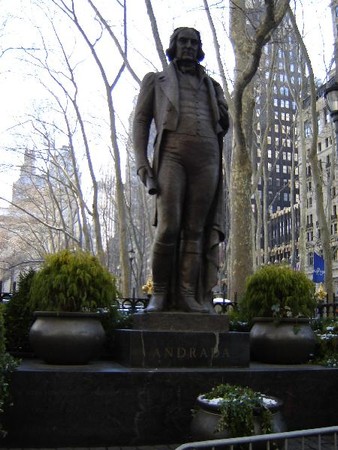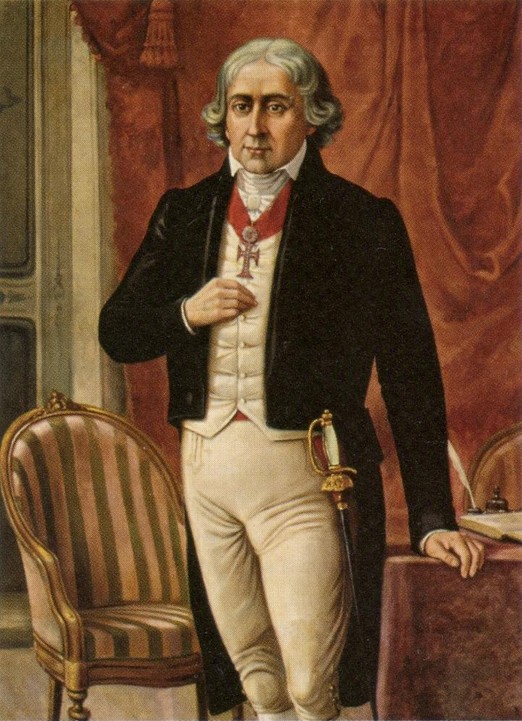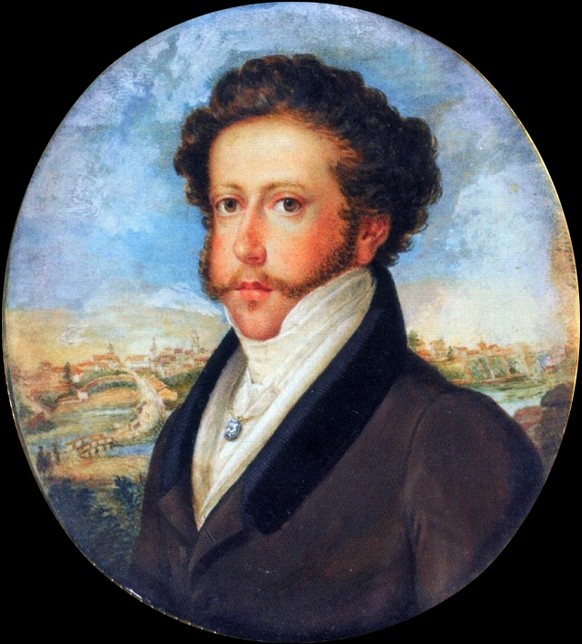José Bonifácio de Andrada e Silva Statue
Introduction
Text-to-speech Audio
Images
Statue of José Bonifácio de Andrada e Silva at Bryant Park
_-_07.jpg)
Statue of José Bonifácio de Andrada e Silva at Bryant Park

José Bonifácio de Andrada e Silva by Benedito Calixto

Pedro I in 1822

Backstory and Context
Text-to-speech Audio
In 1945 Mayor Fiorello La Guardia renamed Sixth Avenue the Avenue of the Americas to celebrate New York’s rising status of a world capital and advocate for the headquarters of the United Nations to be built in the city. La Guardia also hoped to attract consulates to Sixth Avenue for nations of the Western Hemisphere and in renaming the Avenue of the Americas he sought to honor Pan-American ideals. This statue to José Bonifácio de Andrada e Silva is one of seven statues on Sixth Avenue of Latin American leaders. Also at Bryant Park is Benito Juarez of Mexico, at the southern end is Juan Pablo Duarte (1813-1876) of the Dominican Republic and General Jose Artigas (1764-1850) of Uruguay, and at Central Park are José Martí (1853-1895) of Cuba, General José de San Martín (1778-1850) of Argentina, and Simón Bolívar (1783-1830).
José Bonifácio de Andrada e Silva was born June 13, 1763 into a wealthy Brazilian family. His father was a royal functionary and merchant and was one of the wealthiest men in Santos. The family’s status allowed José Bonifácio and his brothers to get a good education and hold high posts in the government. He had an early classical education under Friar Manuel da Ressureição and then studied at the University of Coimbra in Portugal. There was no university in Brazil, so Coimbra was where the Brazilian elite educated their children. While the University focused on a more traditional classical education, José Bonifácio was introduced to the literature and ideas of the Enlightenment and to the sciences. He was particularly interested in mineralogy and spent ten years traveling Europe as part of his studies. He visited France in 1791 and disapproved of the methods of the French Revolution; he formed an opinion against revolutionary movements that involved mobilizing the people.
After ten years of travel and study, José Bonifácio settled in Portugal, married, and took several positions thanks to his scientific studies and connections to the Portuguese elite. He was, for example, professor of mineralogy at Coimbra, supervisor of mines for the kingdom, administrator of the coal mines in Buarcos and iron foundries, and director of the laboratory of the Royal Mint. Until his 50s, José Bonifácio was fully engaged in Portuguese elite society, the government, and intellectual society. This included fighting in the defense of Portugal and the king; in 1808 when Napoleon invaded Portugal, causing King João VI to flee to Brazil, José Bonifácio stayed and fought in the Corps of Academic Volunteers and served several different roles in the defense of the country.
The war with Napoleon caused a shift in Portugal-Brazil relations that would change the trajectory of José Bonifácio’s life. Once the conflict was over, King João VI stayed in Brazil and granted new privileges to the Brazilian people. This angered the Portuguese and gave Brazil a new sense of autonomy. In 1817 Brazilian rebels organized a resistance movement to declare Brazil independent from Portugal. This revolt was unsuccessful and led to a period of repression by the government, which affected José Bonifácio’s brothers. The following year José Bonifácio requested permission to return home to Brazil. He and his family arrived in Brazil in June 1819, settled at his birthplace at Santos, and for a time he focused only on his scientific explorations and studies.
Very quickly, however, José Bonifácio reentered government affairs. He was appointed a counselor to the Crown in August 1820 as instability grew in both Portugal and Brazil. In Portugal demands that the king return to the mother country grew louder, and a revolutionary movement organized a parliament called the Côrtes that called for a constitution and the king’s return. News of the Portuguese revolution caused celebrations in Brazil and in February 1821 demonstrations in Rio de Janeiro called for King João VI to accept the demands of the Côrtes. When his own Royal troops joined the demonstrators, the king was forced to accept the conditions. He returned to Portugal and left his son, Pedro, as regent in Brazil. He also agreed to allow the election of Brazilian representatives to the Côrtes.
In the aftermath of the King’s departure, José Bonifácio was elected as a member of the São Paulo provisional government who drafted a set of instructions to be send to the Côrtes. At this point in 1821, José Bonifácio and his colleagues did not advocate for independence. They continued to endorse a unified kingdom if Brazil had representation in the Côrtes. They also demanded that the increased status and autonomy that Brazil had achieved during the king’s time there be maintained, that an executive government be created in Brazil, and that Portuguese and Brazilian citizens receive the same rights and treatment. José Bonifácio also advocated for the establishment of a university in Brazil and the overall improvement of the education system. While the demands written by the São Paulo provisional government did not seem unrealistic to Brazilians, they were not accepted by the Portuguese Côrtes. When the Côrtes was unaccepting of their terms, José Bonifácio and his cohort turned to demanding independence instead.
José Bonifácio supported independence, but not a messy democratic revolution like he had witnessed in France. He wanted an independence revolution led by the monarch and elite of Brazil and supported a constitutional monarchy. José Bonifácio’s mixture of liberal and conservative ideas made him a perfect ally for Prince Pedro. When José Bonifácio traveled to Rio to present Pedro with the grievances of the São Paulo government, Pedro asked him to become his chief advisor (a role similar to prime minister). As calls for independence began there were three factions vying for power: one that was more allied with the Côrtes, typically merchants and military officers; the second was largely the wealthy elite & government officials who were willing to do a dual monarchy, or move towards independence; and the third was the most radical that advocated for more of the republican trends adopted by other American nations. Pedro held many liberal ideas compared to his father and supported independence and a constitutional monarchy. Thus, once it became apparent that Pedro would support an independence Brazil, many in the third, radical faction joined in supporting the prince.
As Pedro’s chief advisor, José Bonifácio worked to subdue opposition in Brazil and in the press, and established relations with foreign powers. He also forbade the landing of Portuguese military troops in Brazil and demanded that those already in the country return to Portugal. In opposition to the Portuguese parliament, José Bonifácio declared that no laws from the Côrtes be enacted unless approved by the regent, Pedro. Under Bonifácio’s advice, Prince Pedro declared independence on September 7, 1822 and was named Emperor of Brazil on October 12. As a result of his actions, José Bonifácio and his brothers (also government officials fighting for independence) were declared traitors to Portugal.
In the period after independence, José Bonifácio was caught between the liberal and conservative factions of Brazil and strong opposition to some of his policies. He supported many liberal objectives but was still a strict conservative monarchist. He lost support from his elite base when he supported the abolition of slavery and was heavily criticized for using his position to root out personal opponents. Eventually Bonifácio alienated the emperor and his opponents won Pedro I to their side. Pedro I dismissed Bonifácio from his position in July 1823 and in November of that year dismissed the constitutional assembly meant to write a new constitution. Bonifácio and other members of the assembly were arrested and Bonifácio was deported to France. Pedro I established a new elected assembly that drafted a constitution for a stronger central state than what the original assembly proposed. His efforts to centralize power caused more conflict in Brazil, included a rebellion from areas that attempted to secede from Brazil, conflict with the new national legislature formed in 1826, and a rebellion of mercenary soldiers in 1828. During this time, however, Pedro I did succeed in negotiating a treaty with Portugal in 1825 that recognized Brazilian independence.
José Bonifácio was exiled in France for five years before being allowed to return to Brazil in 1829. He retired to secluded Paquetá Island in Rio de Janeiro Bay and returned to his studies. When he returned to Brazil, tension between Pedro I and his opposition was growing into armed conflict in the streets of Rio de Janeiro. As a result, in 1831, Pedro I abdicated the throne of Brazil and returned to Portugal where his daughter’s claim to the throne was being threatened by his brother. Pedro abdicated in favor of his son, who was only five years old, and returned to Europe. Despite their previous conflicts, Pedro I asked his former advisor and friend Bonifácio to be Royal Tutor to his children. This position, unfortunately, put Bonifácio back into the path of controversy as opposition leaders accused him of wanting to bring back the emperor or questioned his tutoring of the young prince. The Brazilian parliament wanted to get rid of Bonifácio and they found an excuse to removed him from his position and put him on trial. The Bonifácio trial lasted from 1833 to 1835; at the end he was absolved of any crime, but the experience took a toll on his health. He spent the last three years of his life working on his studies at Paquetá with his health worsening and died on April 6, 1838 at age 75.
During his lifetime and time in power, José Bonifácio de Andrada e Silva was often a controversial figure who faced much opposition. His stances were between the conservative elites and progressive masses, thus he never quite fit into either faction and faced periodic opposition from both. Later memory placed him in the center of the Brazilian national myth and it was really in the twentieth century that he was seen as a Brazilian legend due to the wider acceptance of liberal reforms. His image of the “Patriarca of Brazilian Independence” was solidified by later generations who saw him as an early supporter of progressive policies that gained momentum later on and as nationalism grew in the twentieth century he was seen as a founding father of the Brazilian nation.
Cite This Entry
Thompson, Kathleen. "José Bonifácio de Andrada e Silva Statue." Clio: Your Guide to History. December 4, 2020. Accessed March 23, 2025. https://theclio.com/entry/21864/tour/1
Sources
Da Costa, Emilia Viotti. The Brazilian Empire: Myths and Histories, Chicago: The University of Chicago Press, 1985.
“José Bonifácio de Andrada e Silva.” Bryant Park. Accessed November 30, 2020. https://www.nycgovparks.org/parks/bryant-park/monuments/37.
“José Bonifácio de Andrada e Silva.” Relics & Selves: Background. Jens Andermann Birbeck College. Accessed November 30, 2020. http://www.bbk.ac.uk/ibamuseum/texts/Andermann01B.htm.
"Statue of José Bonifácio de Andrada." Wikipedia. Accessed November 30, 2020. https://en.wikipedia.org/wiki/Statue_of_Jos%C3%A9_Bonif%C3%A1cio_de_Andrada.
“José Bonifácio de Andrada e Silva.” Bryant Park. Accessed November 30, 2020. https://www.nycgovparks.org/parks/bryant-park/monuments/37.
"José Bonifácio de Andrada." Wikipedia. Accessed November 30, 2020. https://en.wikipedia.org/wiki/Jos%C3%A9_Bonif%C3%A1cio_de_Andrada.
"Pedro I of Brazil." Wikipedia. Accessed November 30, 2020. https://en.wikipedia.org/wiki/Pedro_I_of_Brazil.

